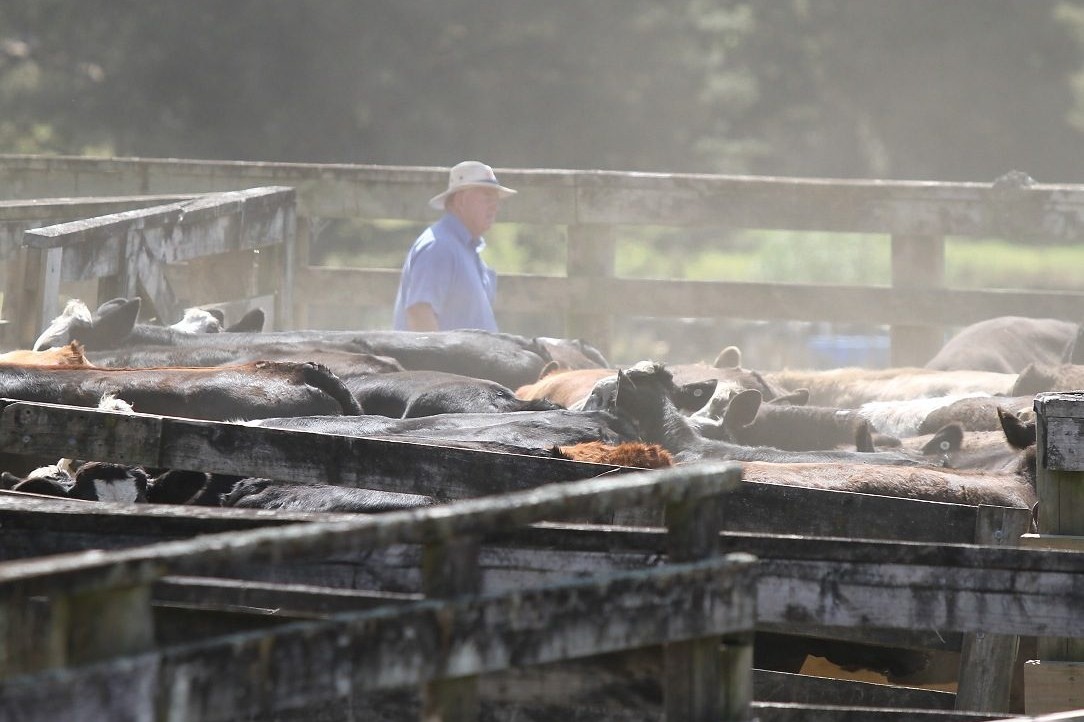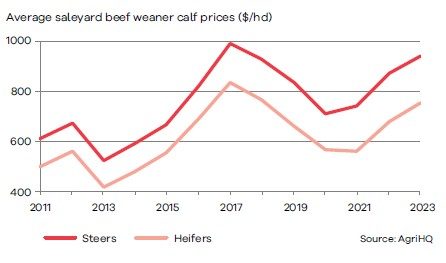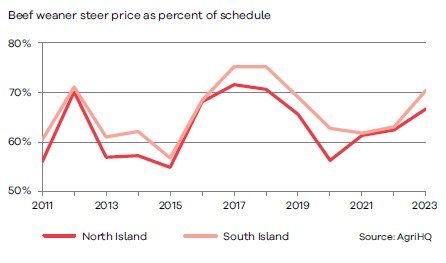Weaner calf market prices strong
Despite rising costs and the effects of Cyclone Gabrielle, weaner calf sales have experienced a boom market, AgriHQ senior analyst Reece Brick reports.

When it comes to cattle markets, there’s rarely a more important spell for store trading than during the autumn beef weaner calf sales. With both buyers and sellers only active over a few weeks, it can make for major swings year-to-year, especially as holding calves through to spring isn’t a viable back-up option, unless there’s extra grass covers grown before winter or supplementary feed on hand.
The year leading to this autumn had been the definition of up-and-down. Through 2017, and 2018 to a lesser extent, the market for beef weaner calves was astounding compared to the sort of money paid anytime beforehand.
Strong schedules and no shortage of feed meant buyers had plenty of cash as they walked into sales. At the other end of the spectrum was 2020, when lockdowns and North Island drought not only scared off buyers but reduced calf weights, sending prices tumbling.

Luckily for beef breeders, returns this year fell into the top-end of what’s been paid the last few years. A welcome relief considering the rising costs to simply operate, not to mention the extra cash flow needed to speed up the repair work post-Cyclone Gabrielle.
A few of the later sales are yet to roll around, but the market mainly found its level early and hasn’t deviated too far from those initial markers. Over a sample of seven key saleyards in each island, the average price for all weaner steers has been $991 or $4.14/kg liveweight in the North Island and $888 or $3.89/kg LW in the South Island. For heifers, the averages to date have been $797 or $3.65/kg LW in the North Island and $698 or $3.27/kg LW in the South Island.
In both instances, these are the second-highest prices ever paid in the North Island, only beaten by 2017, while for the South Island they’re the third highest, where both 2017 and 2018 were stronger.
As a general rule, and as usual, buyers have been more active where feed’s been more abundant. That’s been especially noticeable this season as high trucking costs have pushed buyers to purchase from vendors closer to home. This largely explains why the North Island has led the charge with pricing. The South Island market has been variable, typically stronger through Marlborough and Canterbury which entered into autumn in a solid position, whereas Otago and Southland have usually been softer owing to the dry summer in large parts of these regions.

This isn’t too dissimilar to a year ago. The key differences are the Southland dry dragged deeper into autumn last year, while northern Waikato had its own brief drought in late autumn too. Schedules were similar in the North Island and stronger in the South Island back then. Cash flow has been another factor behind the stronger weaner calf market compared to last year. R2 cattle entered in autumn at or near record high prices, causing some would-be buyers to turn their attention to the younger cattle classes with lower per-head prices.
One point of interest going into the weaner selling season was how Gisborne and northern Hawke’s Bay would handle the series of issues that cropped up due to the damage from Cyclone Gabrielle. While this did lead to a few changes – weaners set to sell through Wairoa were relocated to Matawhero, Stortford Lodge held an extra sale to accommodate cattle that weren’t able to be accessed at the start of March. The market at both locations has performed about as well as other yards with sales, though it’s been reported that other centres on the East Coast such as Dannevirke and Masterton likely sold at higher pricing, but without weight data to be certain.
- Reece Brick is a senior analyst for AgriHQ.
Sales avoid post Gabrielle damage
BY GLENYS CHRISTIAN
Some weaners are coming to sales more than 50 days late due to problems with farm access, says Dean Freeman from Redshaw Livestock in Hawke’s Bay.
The first sales of the season in March and April at Stortford Lodge in Hastings were reduced from the usual two days to one because of the lower numbers yarded.
“The rest will come into our weekly sales, some well into May,” Freeman says. “Or we might do paddock sales.”
Stock from the Wairoa area that would usually come south had gone to the Matawhero sales out of Gisborne because of the main road south being impassable.
But the weaner season had been strong. “That largely comes down to grass,” he says.
NZ Farmers’ livestock agent in the Waikato Gareth Price says given a wet summer, which was good for grass growing, weaners came forward at a lot heavier weights to the Frankton weaner fair.
“They were met with a lot better buying power as people thought there was going to be a drought,” he says.
Although numbers had dropped slightly over the last five years, about 200 weaner steers were sold, along with 300–350 weaner heifers and a similar number of weaner bulls, which were traditionally straight Hereford.
Steers, bulls and heifers were all about 30kg liveweight heavier than usual, which was reflected in prices paid. Straight Angus steers fetched up to $1/kg more and for other classes vendors were 70 cents to $1/kg better off. Yarding numbers were slightly lower.
While the central Waikato wasn’t too badly affected by Cyclone Gabrielle, the north Coromandel Colville weaner sale was cancelled and stock that would have been sold there sent to other saleyards. The offering at the Kauroa weaner fair near Raglan had dropped as farmers’ breeding policies changed, so stock that would have been sold there went “over the hill” to Frankton.
Numbers of breeding cows were down due to changes in farmers’ stock policies and some farms had recently been sold to go into forestry for carbon credits.
Carrfields agent in Northland Reuben Wright says there was a very good run at both the Peria sale where 2500 head were sold and Broadwood where 1500 went under the hammer.
The sales weren’t affected by any cyclone damage.
NZ Farmers’ northern and central South Island agent Regan Laughton says sales had been “very upbeat”.
Stock came to the Temuka weaner sale far heavier than usual with 300kg calves reaching $3.80–$4/kg, “and a handful went for more”.
Lighter steers went for an average of $4–$4.20/kg.
The number of sales had been condensed over recent years to make attendance more attractive to buyers, so stock numbers on offer were similar to previous sales. But there would be an effect of recent sales of farms to be planted in trees for carbon credits.




